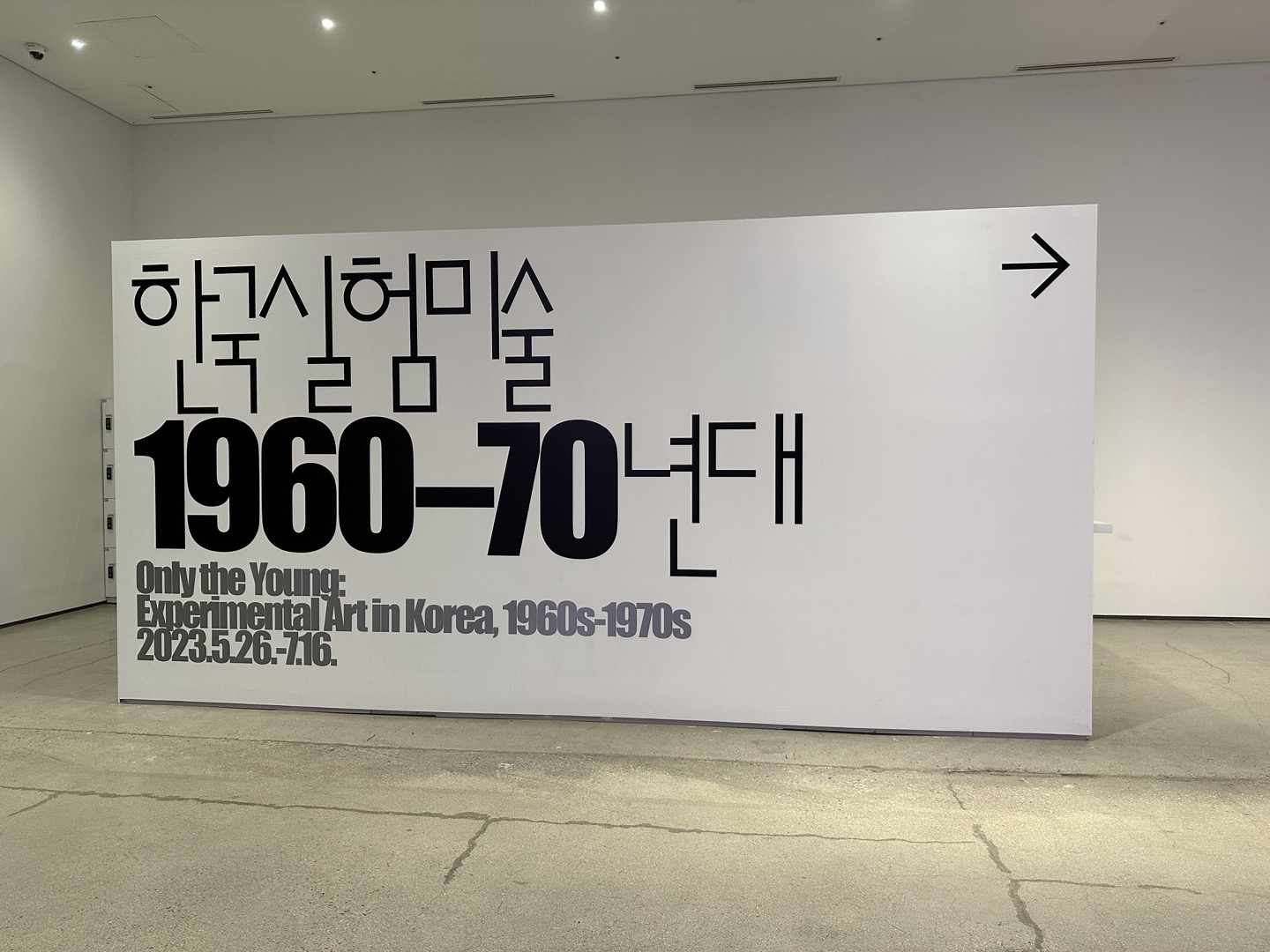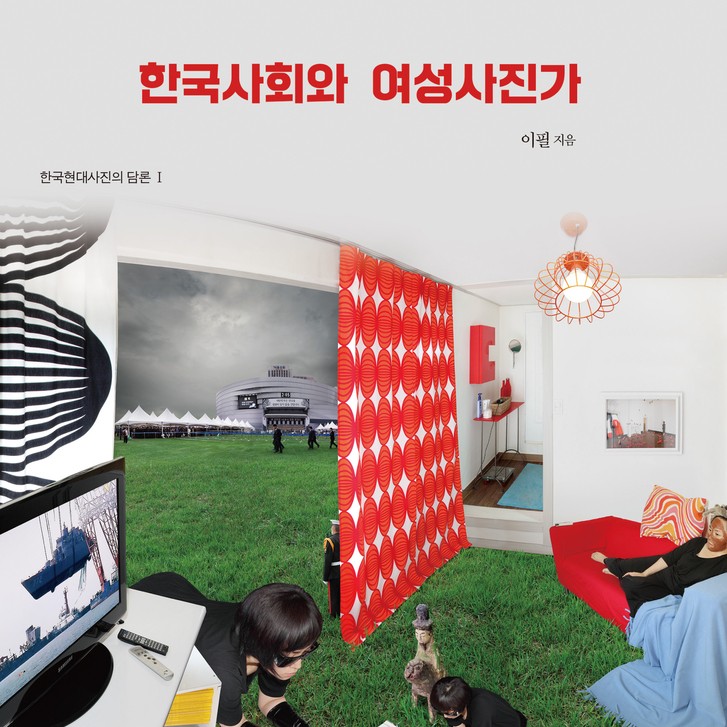While various groups have contributed to the advancement of experimental art through their activities, this article will provide a brief introduction to the prominent groups such as “Mudongin (Zero Group),” “Origin Society,” and ” Sinjeon dongin (New Exhibition Group).”
 Image of the exhibition catalog “Only the Young: Experimental Art in Korea, 1960s – 1970s.” ⓒ MMCA Foundation.
Image of the exhibition catalog “Only the Young: Experimental Art in Korea, 1960s – 1970s.” ⓒ MMCA Foundation.Korean experimental art has expanded the boundaries between genres, delved into the core essence of art, integrated daily life with artistic expression, and aspired to capture the attention of its audience.
During the span between the Art Informel and Dansaekhwa (monochrome painting) movements, the Korean art scene from the mid-1960s to the early 1970s was often labeled as a “transitional” phase. Yet, this time was far from being just a bridge between styles; it was an era rich in diverse pursuits that illuminated novel paths for Korean art. Various experimental art activities emerged during this time, expanding beyond painting and sculpture to embrace object art, performance art, conceptual art, and environmental art. Today, these groundbreaking efforts from that period are recognized as hallmarks of Korea’s experimental art, increasingly gaining appreciation in the broader spectrum of global art history.
Artists of this era formed groups that diverged from the conventional art scene and continued their creative endeavors. The first signs of this change became evident in 1957.
The year 1957 marked a turning point in Korean contemporary art history. From that time on, numerous artists pursued different directions from the existing art scene and formed various new art groups and associations.
Why did so many groups suddenly emerge in a single year? The catalyst was the conflict that arose in 1956 between established artists and younger artists during the National Exhibition. Fatigued by the authoritarian and uniform atmosphere of the established art scene, the younger generation emphasized the essential nature of art and sought to break free from the chaotic zeitgeist.

Left to right: artists Yang Deok Su, Jung Kangja, Chung Chan-seung, Kim Inhwan, Shim Sun Hee, and Kukjin Kang standing in front of Jung Kangja’s artwork ‘Kiss me’ (1967), “The Young Artists Coalition Exhibition” at the National Information Center, Seoul. ⓒ National Information Center.
In The Aesthetics of Korean Contemporary Art, Oh Kwang-Soo suggests that the proliferation of these groups was attributed to changes in the zeitgeist and internal movements within the art world at that time. The young generation of that era had experienced war, and for them, art was not so much about beauty as it was about contemplating existence itself and imparting meaning to life.
During this transformative period, the group Actuel, active from 1962 to 1964, began to explore the realms of experimental art. Comprised primarily of artists in their 30s, Actuel ventured beyond abstract art, incorporating objects into their work.
However, when it comes to the early experimental art groups in Korea, it is crucial to mention groups such as Mudongin (Zero Group) (無同人, 1962–1967). Emerging concurrently with Actuel, Mudongin, formed by students from Hongik University and Seoul National University, explored the depths of object art. Although their early endeavors still showed traces of Art Informel influences, their second exhibition, Experimental Contemporary Art in 1967, showcased a diverse range of objects, including discarded materials, surgical emergency medical equipment, broken dishes, rubber gloves, face masks, shoes, and gas masks. Their work was inspired by movements such as Neo-Dada, Nouveau Réalisme, and Gutai. While they did not develop a systematic understanding of object aesthetics, their work mirrored the shifts occurring among the younger artist generation.
 The members of Mudongin and Sinjeon dongin , with the scenario by Kwangsu Oh (art critic), 'Happening with vinyl umbrella and candles,' December 14, 1967, 4:00-4:40 pm, ‘Chungnyun jakka yeunlipjun’ (Young Artists Coalition Exhibition), Exhibition hall 2, Gallery of Joong Ang Gongbokwan Hwarang (Gallery of the National Information Center), Seoul, Korea.
The members of Mudongin and Sinjeon dongin , with the scenario by Kwangsu Oh (art critic), 'Happening with vinyl umbrella and candles,' December 14, 1967, 4:00-4:40 pm, ‘Chungnyun jakka yeunlipjun’ (Young Artists Coalition Exhibition), Exhibition hall 2, Gallery of Joong Ang Gongbokwan Hwarang (Gallery of the National Information Center), Seoul, Korea.In 1967, Mudongin played a pivotal role in the landmark exhibition for Korean experimental art: the Young Artists Coalition Exhibition, held from December 11 to December 16 (hereinafter referred to as the Coalition Exhibition). Among the groups participating at that time were the Origin Society and the Sinjeon dongin (New Exhibition Group). These three groups had a significant influence on Korean experimental art.
The artworks of the participating artists in this exhibition collectively encompassed the trends of global contemporary art of the 1960s, including Pop Art, Neo-Dada, Op Art, Environmental Art, and Happenings. While the exhibition did not establish a theoretical foundation for the works, it showcased the proactive spirit of young artists in their pursuit of challenges.
The group Origin Society (1963), which participated in the exhibition, initially leaned toward Art Informel tendencies. However, their direction changed after participating in the Coalition Exhibition. All members of the group pursued a geometric abstraction language characterized by rational and logically structured geometric forms and structures, opposing the Informel concept. Through their activities, the landscape of Korean abstract art underwent rapid change.
 Kang Kukjin, 'The Joy of Vision,' 1967, Penicillin bottles, colored papers, table, mirror, Dimension variable, “Young Artists Coalition Exhibition,” Exhibition hall 2, Gallery of Joong Ang Gongbokwan Hwarang (Gallery of the National Information Center), Seoul, Korea. The National Museum of Contemporary Art Korea collection. Image: artist Kang Kukjin website.
Kang Kukjin, 'The Joy of Vision,' 1967, Penicillin bottles, colored papers, table, mirror, Dimension variable, “Young Artists Coalition Exhibition,” Exhibition hall 2, Gallery of Joong Ang Gongbokwan Hwarang (Gallery of the National Information Center), Seoul, Korea. The National Museum of Contemporary Art Korea collection. Image: artist Kang Kukjin website.Meanwhile, Mudongin and Sinjeon dongin pursued an approach that employed objects in installation works and tackled social reality through Happenings or performances. By rethinking the environment, they broadened their artistic perspective from the confines of a two-dimensional canvas to embrace a holistic three-dimensional realm, intertwining time and space and fostering a deeper engagement with their audience.
The activities of Mudongin and Sinjeon dongin had a significant influence, particularly on the later-established AG (Korean Avant-Garde Association) and ST (Space & Time Group). After the Coalition Exhibition, Mudongin contemplated forming AG with Origin Society artists and took initiatives to promote Happening art alongside Sinjeon dongin artists.
Building on the activities of the groups participating in the Coalition Exhibition, other groups emerged on the scene, such as the AG and ST, along with The Fourth Group (1970), Shincheje (New System Group) (1970–1974), and Esprit (1972–1974).
This article will continue next week.
References
- 국립현대미술관(The National Museum of Modern and Contemporary Art, Korea, MMCA)
- 구겐하임 재단(The Solomon R. Guggenheim Foundation)
- 오광수, “한국현대미술의 미의식”, 재원, 1995






























